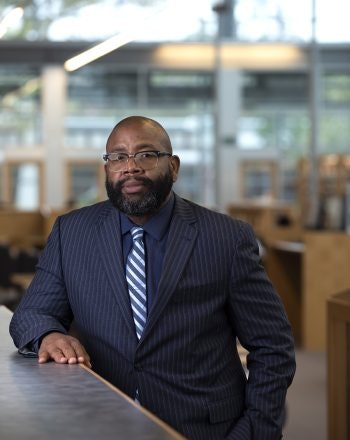 Dr. Keith Curry
Dr. Keith Curry
Learning from HSIs: The Concept of Servingness
The concept of “servingness” is not new. It has long been associated with the Hispanic-Serving institution (HSI) designation that the Federal government established in the 1992 reauthorization of the Higher Education Act to recognize and provide funding and resources to colleges and universities that had a fulltime undergraduate enrollment of at least 25% Latinx. Today, there are more than 600 HSIs in which approximately two-thirds of all Latinx undergraduate students are enrolled.
 Dr. Frank Harris
Dr. Frank Harris
Why Black-Serving Institutions Matter Dr. J. Luke Wood
Dr. J. Luke Wood
Indicators of Black-Servingness
Building on Garcia’s (2019) concept of servingness and accounting for the need for more higher education institutions that are committed to serving underserved students, including but not limited to Black students, we offer these indicators of what servingness may look like at BSIs. This is not an exhaustive list nor a checklist. But rather an aspirational set of commitments for educators who are serious about creating and sustaining BSIs. The indicators are organized into five broad categories reflecting priority areas for Black-Servingness: Mission, Leadership, and Commitment; Representation and Belonging; Institutional Accountability and Effectiveness; Curricula and Co-Curricular Programs; Support and Wellness.
Mission, Leadership and Commitment
1. The institution’s mission, vision, and strategic priorities explicitly affirm a commitment to underserved students, including but not limited to Black student success and Black-Servingness.
2. The executive leadership team includes diverse leaders, including but not limited to Black leaders and others who demonstrate a pro-Black racial consciousness and perspective.
3. The institution maintains authentic partnerships and outreach efforts that actively support and engage local Black communities, residents, educational organizations, and the business community.
Representation and Belonging
4. Black student representation in the undergraduate population reflects, at a minimum, the proportion of Black residents within the state or local community.
5. Diverse faculty, including but not limited to Black faculty members, are meaningfully represented across the institution’s full-time, tenure, and tenure- track ranks.
6. A diverse student population, including but not limited to Black students, is represented in student government, clubs and organizations, and other campus leadership bodies.
7. There are identity-affirming spaces that foster a sense of belonging for underserved students, including but not limited to Black students, featuring art, murals, and photographs of prominent alumni and other individuals who have made important contributions to society.
Institutional Accountability and Effectiveness
8. Underserved students, including but not limited to Black students, have outcomes that match or exceed those of the overall student population on key indicators of student success, including persistence, achievement, graduation/completion, and transfer.
9. Institutional research regularly assesses the needs and experiences of underserved students, including but not limited to Black students. This includes routinely disaggregating student success data by race/ethnicity to identify and address patterns of disproportionate impact.
10. Institutions’ student outcomes data are publicly available and disaggregated by race/ethnicity at the course and program levels. Data is also discussed during campus-wide, department, and division meetings.
Curricula and Co-Curricular Programs
11. Underserved students, including but not limited to Black students’ experiences, perspectives, and intellectual contributions, are integrated throughout the institutions’ academic programs and curricula.
12. A diverse range of campus engagement and cultural programs exists to support the holistic development and well-being of underserved students, including but not limited to Black students.
13. The institution intentionally celebrates and honors underserved students, including but not limited to Black students, through initiatives such as honors programs, honors colleges, graduation celebrations, and awards.
Support and Wellness
14. Robust supports are in place to address underserved students, including but not limited to Black students’ basic needs insecurities, including food, housing, health services, and transportation.
15. Underserved students, including but not limited to Black students, have access to culturally affirming mental health and wellness professionals who recognize and validate their unique lived experiences.
16. Adequate financial support–including grants, scholarships, and subsidized loans–is available to help underserved students, including but not limited to Black students, afford to attend without accumulating excessive debt.
Challenges and the Path Forward
We recognize many institutions will be reluctant, if not unwilling, to embrace the concept of Black-servingness transparently because of current policies and actions, and the attacks on diversity, equity, inclusion, and accessibility in higher education. However, now is not the time to pull back; rather, it is time to deepen institutional commitment to our students and Black-servingness in particular. Regardless of these policies and the public perception of higher education, Black students are deciding if higher education is for them. Many are asking:
Do I belong in college? Am I college material? Can I be successful in college? What might college offer me? For these students, a transparent commitment to Black-servingness can be the difference between them deciding to enroll at a particular college or university or to invest their time, energy, and resources elsewhere, such as joining the workforce full-time or the military. Thus, some reticence or reluctance to Black-servingness can be a turn-off to future and current Black students.
At a time when Black and other race-conscious presidents and CEOs across the country are being publicly attacked and threatened with votes of no confidence for advancing–or being transparently committed–to serving underserved students, it is critical to affirm and codify Black-servingness in both policy and practice. Resistance to these efforts is often an indication that leaders are doing what is right and actively working to dismantle centuries-old oppressive structures. Supporting student success, including Black student success, is not only acceptable but also a responsible course of action for higher education leaders.
In closing, we issue this call to action: States that are truly committed to the education, well-being, and thriving of their underserved, including but not limited to Black residents, must enact legislation and supporting policy that advances Black-servingness in public colleges and universities. We also urge institutions that aspire to foster Black student success to align their priorities and invest resources in ways that transparently support Black-servingness.
Dr. Frank Harris III is a professor of Postsecondary Education and director of the Community College Equity Assessment Lab at San Diego State University.
Dr. Keith Curry is president of Compton College and CEO of the Compton Community College District.
Dr. J. Luke Wood is president of Sacramento State University.
Behind the Desk: Perspectives of Black Community College CEOs is a column edited by Drs. Tina M. King, Jamal A. Cooks and David M. Johnson.















